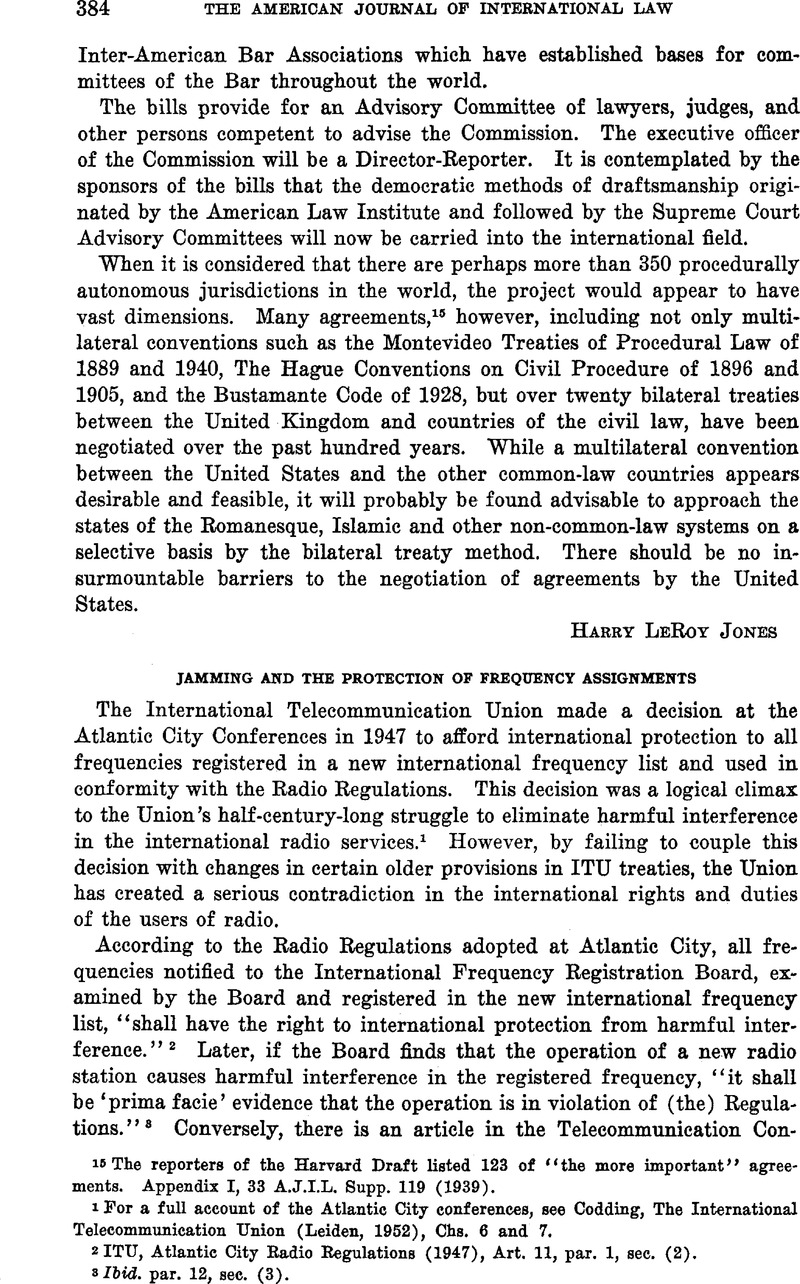No CrossRef data available.
Article contents
Jamming and the Protection of Frequency Assignments
Published online by Cambridge University Press: 30 March 2017
Abstract

- Type
- Notes and Comments
- Information
- Copyright
- Copyright © American Society of International Law 1955
References
1 For a full account of the Atlantic City conferences, see Codding, The International Telecommunication Union (Leiden, 1952), Chs. 6 and 7.
2 ITU, Atlantic City Radio Regulations (1947), Art. 11, par. 1, sec. (2).
3 Ibid. par. 12, sec. (3).
4 ITU, Buenos Aires Telecommunication Convention (1952), Art. 45. This article is identical to that contained in the Atlantic City Regulations. Before 1947, however, members were only obliged to prevent harmful interference “as far as possible.” See, for instance, ITU, Madrid Telecommunication Convention (1932), Art. 35.
5 See, for instance, ITU, St. Petersburg Telegraph Convention (1875), Arts. 7 and 8.
6 Buenos Aires Convention, op. cit. supra, Arts. 29 and 30.
7 For the purposes of this discussion, it is assumed that the country broadcasting the unwanted programs is using a frequency duly registered in the international frequency list. Different problems would arise if the broadcast was made on a frequency on which the broadcaster had no claim. Recently, for instance, a third party’s broadcasts on a registered frequency were interfered with by country A jamming a propaganda broadcast, using a directional antenna, originating in country B. The third party was forced to request the country making the propaganda broadcasts to cease operation so that the jamming country would, in turn, stop making interference.
8 The use of jamming as a method of stopping unwanted communications was touched upon at the 1932 Madrid Conference when the radio convention was being merged with the telegraph convention to form the first Telecommunication Convention. A draft article was submitted, to occupy the same place that Art. 29 does in the Buenos Aires Convention, which read as follows: “Les gouvernements contractants se réservent le droit d’arrêter la transmission de toute télécommunication ou de brouiller toute émission radioélectrique jugées dangereuses pour la sûreté de l’Etat ou contraires aux lois du pays, à I’ordre public ou aux bonnes moeurs, à charge d’en avertir immédiatement le bureau ou la station d’origine, sauf dans le cas où il y aurait inconvénient grave à émettre cet avis.” 56 Journal télégraphique 161–162 (1932). When the article appeared in the Madrid Convention, the phrase concerning jamming of radio transmissions had disappeared. In his report to the Secretary of State, the American delegate made the following statement: “The … article has been used as the basis of censorship of press messages in various countries and an attempt was made by some delegations to have its terms made more restrictive so that it might have been advanced as the basis for even stricter censorship of such messages. Your delegation … successfully resisted such efforts.” United States Department of State, International Radiotelegraph Conference, Madrid, 1932, Report to the Secretary of State by the Chairman of the American Delegation with Appended Documents, Conf. Ser. No. 15, 1934, pp. 335–336. As praiseworthy as were the American intentions, if the phrase had been left in the convention, it would have been extremely difficult for the delegates at the Atlantic City Conferences to ignore the contradiction that they were creating.
9 See ITU, Documents of the Plenipotentiary Conference, Buenos Aires, 1952 (Buenos Aires, 1952, mimeographed), Nos. 13, 102, 135 and 144.
10 Ibid., Doc. 446, p. 21.
11 Ibid. 15.
12 Ibid., Doc. 448, p. 12.
13 Buenos Aires Convention, op. cit. supra, Recommendation No. 2. Reference to Art. 28 was added at the last minute. Art. 28 “recognized the right of the public to correspond by means of the international service of public correspondence.”
14 The resolution was adopted by an unrecorded vote of 49 to 11, with 9 abstentions, after a suggestion to delete all reference to Arts. 29 and 30 was rejected by a vote of 43 to 22, with 5 abstentions. Buenos Aires Documents, op. cit. supra, No. 488, pp. 11 and 12. See the discussions in Doc. 446, pp. 11–21, and Doc. 448, pp. 2–13.
15 For the manner and the time of the coming into effect of the high-frequency broadcasting portion of the new international frequency list, see ITU, Agreement for the Preparation and Adoption of the New International Frequency List for the Various Services in the Bands Between 14 kc/s and 27,500 kc/s With a View to Bringing Into Force the Atlantic City Table of Frequency Allocations, Geneva, 1951, Art. 11. See also United States Department of State, Telecommunications Policy Staff, Report of the United States Representative on the Administrative Council of the International Telecommunication Union, Ninth Session, May 1–29, 1954, pp. 4 and 5.


